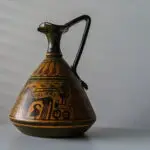The origin of the olive tree goes all the way back to the beginning of Western Civilization. They were shown to be grown in Crete around 2500 B.C. They soon spread to Greece, Rome, and other areas of the Mediterranean. How do Italians eat Olives?

Olives are a staple of Italian cooking. Olives and olive oil are used in many dishes in Italian cooking from pasta sauce, bread, salad, and even fried. They can also be served as an appetizer with cheeses, cured meats, and wine before dinner.
Below we will look at the history of the olive, its uses in Italian cooking, and tips on eating raw olives.
The Olive Tree
The olive tree is an evergreen tree and can grow to over 50 ft high. If they are pruned they can be kept around 30 feet. The olive requires a long and hot growing season to ripen properly. Any early frost can damage the fruits. Chilly winters help the fruit begin to grow in the spring.
The olive tree can live for over 500 years and will be able to grow back even if they are chopped down near the ground level. Small sprouts will begin to form and continue to grow into a full tree if left unattended.
Olives
Olives begin as green fruit and will turn a purplish black when they are ripe. Some varieties however remain green and others can turn brown. They will vary in flavor and oil content depending on the variety. They will also vary in shape from round to oval or elongated.
Olives are often trimmed early in the spring to allow the fruit to grow larger. Olives that remain green are harvested anytime after they reach the proper size. After that, they can be picked at any time. They however must be handled gently since they can bruise easily.
Olives in Italian Cooking
Olives are a staple of Italian cooking. Olives can be used to make olive oil which is often used in many aspects of cooking from boiling water to seasoning bread. Black olives can be chopped up and added to tomato sauce for use on many pasta dishes. They can also be crushed with tomatoes to make a crispy bruschetta.
Pitted olives can be chopped with garlic and made into a tapenade. Sliced olives can be combined with balsamic vinegar, olive oil, and other seasonings and applied to chicken to make a fast and easy chicken marinade. Olives can also be used in a veggie sauce with chopped tomatoes, onions, garlic, and red peppers.
Another popular olive dish is a Mediterranean salad. Combine baby salad leaves and a light dressing with some feta cheese, olives, and tomatoes. It can also be served with bread. Olives can be combined with cooked rice after it has been cooled, minced garlic, chopped tomatoes, lemon juice, and other herbs to stuff tomatoes.
Olives can be kept in your fridge and added to an antipasti platter or a snack with a glass of wine before dinner. The olive marinade will keep for weeks and you can add new olives, olive oil, and fresh herbs when needed. Stir them occasionally to ensure an even mixture and use a slotted spoon to leave the mixture.
Olive Oil in Italian Cooking
Olive oil is an important ingredient in Italian cooking. It is also used to prepare Italian salads and many Italian seasonings. It is used in baking, frying, grilling, sauteing, and marinating. It is present in nearly every part of Italian cooking from pizzas to baked food products including bread.
Eating Raw Olives
Eating a pitted olive is considered to have the most flavor but leaves you with a dilemma. What is the proper way to discard the pit found in the olive? Below we will give you a few suggestions to discard the pit at your next social gathering.
Picking it out
When served with cured meats, cheeses, and olives it’s appropriate to use your fingers to remove the pit after consuming the olive. Use your free hand to disguise the pit as you remove it from your mouth with your other hand.
Using a Fork
If your salad or other meal includes an olive with pits, try eating around the seed of the olive and pushing the seed onto the fork to remove it from your mouth.
No Pit Bowl
In some instances, there is no place to discard your pits when you are sampling olives as a pre-dinner snack. If there is no place to put your pits, you can either place them on your plate or even fold them into a napkin for disposal later.
Olives on Toothpick
When a pitted olive is served on a toothpick, you can eat around the pit and discard it with your thumb and finger after you separate the olive from the seed.
Different Sizes
Smaller olives may require you to put the entire olive in your mouth to separate the pit, but for larger olives, it may be possible to bite around the pit without needing to place the entire olive in your mouth. This will enable you to discard the pit without needing to retrieve it from your mouth at a later time.
Final Tips
It is considered bad etiquette to gnaw on the pit at any time. Large olives are an exception to this but it should be avoided when possible. The best option when earring olives are napkins. They will help your fingers from becoming greasy, as well as give you a discreet place to dispose of the pit when you need to get rid of it.
Conclusion
Olives and olive oil are staples of Italian cooking. They can be added to many dishes including salads, pasta, and bread, as well as served as an appetizer with cured meat, cheese, and a nice glass of wine.
Olive oil is in baking, grilling, frying, sauteing, as well as marinades. Olive oils are often used in baking including loaves of bread and pizzas.
- The Top Restaurants Specializing in Truffle Dishes - August 10, 2023
- Truffle Panna Cotta: A Decadent Dessert Recipe for Truffle Lovers - August 7, 2023
- Truffle Scrambled Eggs: A Luxurious Breakfast Delight - August 7, 2023








